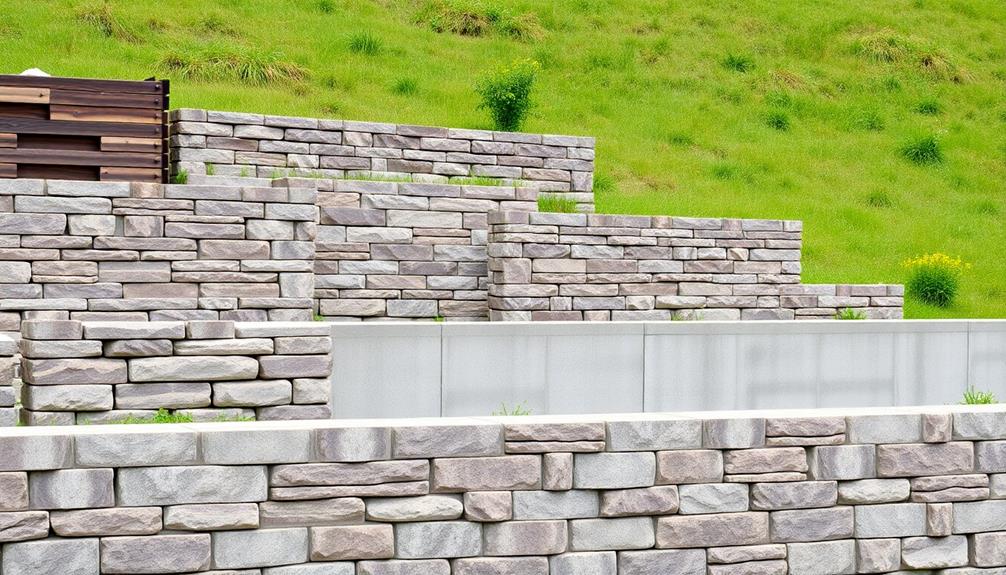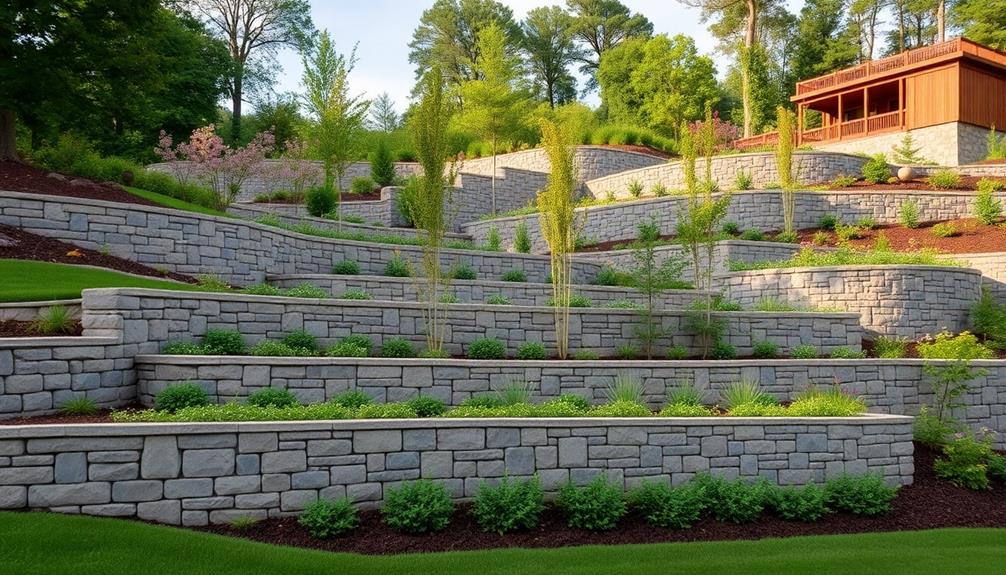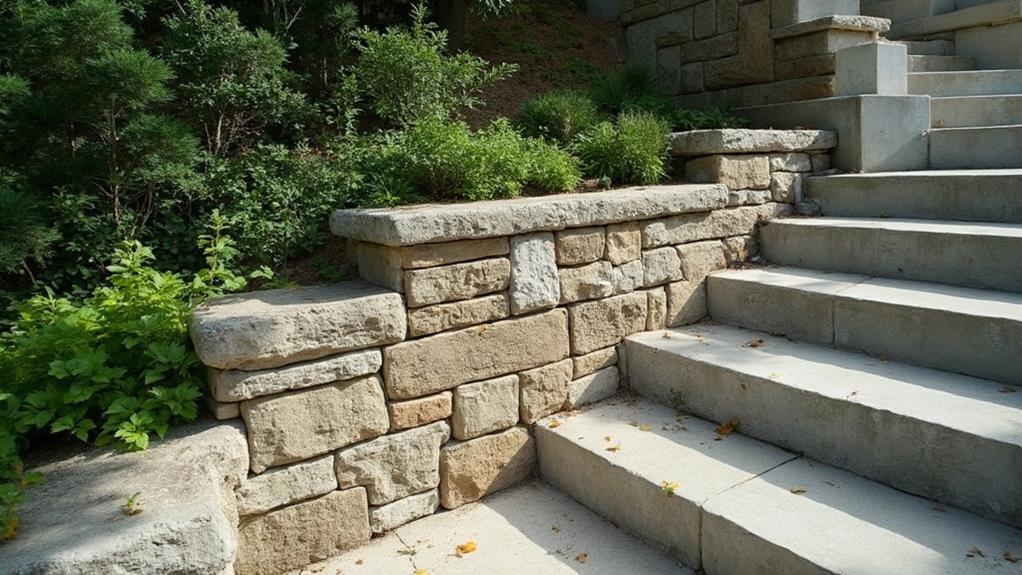The evolution of retaining wall construction is a journey through technological advancements and cultural milestones. Ancient societies like the Mesopotamians and Egyptians implemented monolithic masonry for flood control, leading to dry-stacked stone walls by Greeks and Romans. The Romans also pioneered the use of lime mortar, increasing structural resilience and enabling artistic flourishes. The Industrial Revolution introduced brick and reinforced concrete, followed by modern methods such as gabion baskets and precast systems. Contemporary techniques incorporate geosynthetics and recycled materials to prioritize sustainability. Each historical phase reflects society's growing understanding and innovation in creating resilient structures that meet diverse terrains.
Table of Contents
ToggleWalls Contractor Highlights
- Ancient civilizations used primitive stone structures and monolithic masonry for flood control and terraced landscapes.
- The Roman introduction of lime-based mortar increased tensile strength and aesthetic design in retaining wall constructions.
- Dry stone construction showcased human ingenuity through precise stone selection and interlocking techniques without the use of mortar.
- The Industrial Revolution promoted the use of reinforced concrete and gabion baskets for stronger and flexible retaining structures.
- Contemporary innovations focus on sustainable materials, such as geosynthetics, and environmentally-friendly design principles like green infrastructure.
Types of Retaining Walls

In the domain of retaining wall construction, three prominent types include gravity wall designs, reinforced wall options, and anchored wall systems, each serving distinct structural purposes. Gravity walls rely on their mass to resist earth pressure, making them suitable for scenarios where space allows for substantial wall thickness. These walls can be made from materials like limestone and granite, especially when aesthetic appeal and durability are important.
Conversely, reinforced walls incorporate steel or geosynthetic materials to enhance strength, while anchored wall systems utilize cables or tendons driven into the earth to provide additional support in challenging conditions.
Gravity Wall Designs
Amidst the diverse methodologies in retaining wall construction, gravity wall designs stand out as one of the most enduring and fundamental types. Renowned for their simplicity and robustness, gravity walls leverage their massive weight to counteract the lateral pressure of earth behind them.
These structures primarily consist of heavy materials such as concrete or stone, designed to be substantially wider at the base than at the top to enhance stability. The use of natural forces, alongside strategic engineering, guarantees these walls serve as a reliable solution for various applications, from landscape retaining to infrastructure development.
Integral to these designs is the concept that gravitational forces alone support and maintain their position without the need for additional anchoring systems. This approach offers remarkable advantages:
- Simplicity in Construction: Their straightforward design reduces the complexity and time needed for installation.
- Versatility of Materials: A variety of locally available materials can be utilized, aiding in aesthetic integration with existing landscapes.
- Low Maintenance Requirements: Once established, gravity walls require minimal upkeep, making them a cost-effective choice.
For those seeking a connection with time-tested engineering methods, gravity walls provide a sense of reliability and enduring utility across myriad projects.
Reinforced Wall Options
While gravity wall designs harness weight for stability, reinforced wall options introduce additional structural support through various reinforcement techniques, thereby opening new avenues in construction methodologies.
Reinforced retaining walls are integral to modern construction, offering durability and adaptability to diverse environments. Among these, cantilever walls stand out, using reinforced concrete sections shaped like an inverted "T" or "L" to leverage earth pressure efficiently. This design employs the concrete's tensile strength, supported by steel reinforcements, to resist lateral earth forces efficiently.
In contrast, counterfort walls, though similar, incorporate triangular supports on the rear side of the wall. These vertical wall extensions further strengthen the overall structure against bending stresses, allowing for increased wall heights and load-bearing capabilities.
Additionally, mechanically stabilized earth (MSE) walls use layers of compacted soil alternated with reinforcing materials such as geosynthetics or steel strips, creating a composite structure that accommodates significant loading while reducing material requirements.
Each type plays a distinct but interconnected role within construction communities, offering members a choice of solutions that can be tailored to specific geotechnical requirements and aesthetic preferences. These options, characterized by the thoughtful integration of modern engineering practices, guarantee that projects maintain integrity, strength, and reliability, even under demanding conditions.
Anchored Wall Systems
Among the various types of retaining walls, anchored wall systems offer a robust solution for challenging site conditions. These systems are particularly valuable in scenarios where traditional gravity or cantilever walls might falter due to the inadequacy of soil strength or the requirements for additional load resistance.
Anchored wall systems thrived in popularity due to their ability to incorporate cables or other stays to provide enhanced stability, allowing them to manage substantial lateral forces imposed by the earth. This broad functionality makes them an ideal choice for projects that demand a reliable and steadfast wall design.
Anchored walls consist of a sturdy face, often made from reinforced concrete, and interconnected anchors embedded into the soil or rock behind them. The anchors are tensioned, ensuring that the wall retains its structural integrity under pressure. This setup delivers essential support for scenarios that might otherwise become geotechnically demanding.
Key features of anchored wall systems:
- Versatility: Suitable for diverse applications, from supporting urban excavations to bolstering dam structures.
- Adaptability: Can be employed in soft or fractured soils, thanks to varying anchor lengths and configurations.
- Reliability: Offers extended durability and stability, even in extreme environmental conditions.
These attributes solidify anchored wall systems as a preferred choice.
Benefits

Retaining walls offer substantial benefits that extend beyond their fundamental purpose, effectively combating erosion by stabilizing soil on uneven terrain, which consequently enhances property stability and reduces maintenance needs.
For example, boulder walls provide an eco-friendly solution with minimal upkeep requirements. These structures also contribute to the aesthetic appeal of a landscape, providing flexible design options that can integrate seamlessly with natural surroundings.
Additionally, they maximize space utilization by creating level areas suitable for a wide range of uses, such as gardening, recreation, or additional construction.
Erosion Control Advantages
Erosion control emerges as a crucial advantage of modern retaining wall construction, serving as both a protective and aesthetic enhancement for landscapes. These walls effectively impede soil displacement caused by wind and water forces, thereby safeguarding the integrity of gardens, lawns, and other green spaces. Through strategic design and materials, retaining walls harness environmental elements like rainwater to minimize erosion's adverse impacts, which includes the loss of fertile topsoil and subsequent degradation of the landscape.
The erosion control benefits of retaining walls are significant for communities that cherish and wish to maintain their natural surroundings. They offer practical solutions that can be tailored to specific geographic and climatic conditions, catering to local landscapes and supporting the ecosystems that thrive within them. The adoption of retaining walls in landscaping fosters environmental harmony, which resonates with those who seek to be stewards of the land they inhabit.
Preservation of soil health: Retaining walls help maintain the richness and stability of soils, ensuring continued plant growth and robustness.
Minimization of water runoff: By controlling water flow, these structures reduce the potential for damaging floods.
Enhanced landscape aesthetics: Thoughtfully designed walls add visual appeal to outdoor spaces.
Increased Property Stability
Beyond their aesthetic and ecological benefits, retaining walls substantially enhance property stability, which is a critical concern for both residential and commercial developments. These structures are meticulously engineered to support sloped terrain, thereby preventing landslides and soil erosion that could otherwise jeopardize the foundational integrity of buildings.
By distributing lateral pressure exerted by earth masses, retaining walls provide essential support and reinforce the earth, offering peace of mind to property owners and ensuring the longevity of their investments.
Retaining walls are particularly advantageous in areas prone to heavy rainfall or seismic activity, where ground stability poses a significant challenge. The materials and construction techniques in retaining wall design are chosen with precision, tailored to the specific geological conditions and anticipated stress factors of the site.
With proper implementation, they create secured environments, offering people the sense of safety and belonging they seek in a community.
In addition to stabilizing slopes, retaining walls serve to maximize usable land space by creating tiered levels on otherwise unusable inclines. This versatility transforms properties, offering functional landscapes for gardening, walkways, and additional structures, contributing to a cohesive, well-integrated environment.
Aesthetic Design Options
As stability concerns are addressed, attention often turns to the aesthetic appeal of retaining walls, which play a vital role in enhancing the visual landscape of any property. These structures, once purely functional, have evolved into design elements that meld utility with beauty, offering considerable benefits.
Aesthetic retaining walls can transform outdoor spaces, embedding a sense of identity and character that resonates with property owners and visitors alike. By enabling the integration of personal style and architectural design, these walls not only fulfill structural needs but also contribute to the inviting ambiance of a home or public space.
The benefits of aesthetically designed retaining walls include:
- Enhanced Curb Appeal: A well-designed wall can considerably boost the visual attractiveness of a property, creating a harmonious connection with the surrounding environment.
- Variety of Material Choices: From natural stones to modern composites, the selection of materials enables customization that aligns with individual preferences and architectural themes.
- Color and Texture Variations: The option to incorporate different hues and textures allows for the creation of distinctive patterns, adding depth and dimension to outdoor settings.
Ultimately, these aesthetic options provide homeowners with the opportunity to curate personalized landscapes that appeal to a shared desire for beauty and belonging.
Space Utilization Efficiency
When constructing retaining walls, effective space utilization becomes an important advantage, particularly in areas with limited land availability. This strategic approach allows communities to optimize land use, transforming previously unusable or hazardous slopes into valuable, functional spaces.
The efficiency of retaining wall systems lies in their ability to elevate, contain, and stabilize varied terrain, effectively expanding usable ground. This advantage is especially vital in urban areas, where the need to maximize available space is paramount.
By constructing retaining walls, municipalities and developers can create new opportunities for residential, commercial, and recreational development. This process does not merely address structural necessities but also aligns with the growing desire for efficient land management and sustainable urban planning.
In other words, retaining walls contribute significantly to the creation of green spaces, parking areas, and terraces, meeting the demands of growing urban populations while respecting environmental considerations.
Moreover, the adoption of advanced construction materials and techniques enhances the durability and sustainability of retaining walls, ensuring long-term benefits. This approach fosters a sense of unity among stakeholders—engineers, architects, and city planners—driving innovation and promoting community well-being through responsible space management. In doing so, retaining walls pave the way for resilient and thriving communities.
Ancient Construction Methods

In examining ancient construction methods for retaining walls, one encounters a rich tapestry of ingenuity and adaptation that includes the utilization of early stone wall techniques, the ingenuity behind ancient mortar innovations, and the simplicity yet effectiveness of dry stone construction methods. These techniques not only reveal the resourcefulness of ancient civilizations in utilizing available materials but also highlight the empirical understanding they developed to combat erosion and stabilize terrain. To better comprehend these methods, the table below outlines their key features and purposes:
| Technique | Features and Purposes |
|---|---|
| Early Stone Wall | Utilized large, uncemented stones for structural stability |
| Ancient Mortar Innovations | Employed lime-based mixtures to bind stones together |
| Dry Stone Construction | Relied on stone stacking without mortar for adaptability |
Early Stone Wall Techniques
Dating back thousands of years, early stone wall techniques represented some of humanity's initial attempts at engineering functional structures to withstand environmental pressures. These ancient methods leveraged locally sourced stone, which was meticulously shaped and stacked without the use of modern binding materials, to create durable and enduring edifices. This approach embodied a communal effort that extended beyond mere construction, as societies gathered to fortify their settlements against the forces of nature. In this way, early stone wall techniques not only served practical purposes but also fostered a shared sense of accomplishment and identity among their builders.
Key characteristics of early stone wall construction included:
- Dry Stone Walling: This technique involved stacking stones without using any bonding agent, obtaining stability through strategic placement and the rock's natural weight.
- Cyclopean Masonry: Large, irregular blocks of stone were often used, named due to the mythic perception that only giants could maneuver the immense weight.
- Inclined Layers: Stones were laid at a slight angle against the earth's natural forms to enhance the wall's stability and resistance to sliding forces.
Collectively, these techniques exemplify an era marked by ingenuity and a profound relationship with the Earth's natural resources.
Ancient Mortar Innovations
While early stone wall techniques showcased resourcefulness through dry stacking, the advent of mortar marked a transformative period in ancient construction practices. This breakthrough brought about the fusion of disparate materials, binding stones together to create a cohesive and resilient structure.
Mortar innovations allowed for the seamless integration of various natural and man-made components, forging stronger retaining walls that could withstand the forces of nature over time. Ancient builders, in their quest for permanence and durability, experimented with different binding agents such as lime, gypsum, and volcanic ash, discovering that certain combinations yielded enhanced adhesiveness and robustness.
Lime-based mortars, favored for their versatility, became a cornerstone in both ancient Egyptian and Roman construction techniques. In Rome, the development of hydraulic cements, which set underwater, enabled engineers to construct sophisticated aqueducts and port structures. The addition of pozzolana, a volcanic ash, to lime mortars dramatically enhanced the strength and flexibility of the retained structures.
In this era, the strategic use of mortar not only added tensile strength but also allowed for aesthetic embellishments, enabling the crafting of elaborate and architecturally significant barriers. These innovations symbolized an era of engineering ingenuity, fundamentally changing the landscape of ancient architecture.
Dry Stone Construction Methods
Dry stone construction methods emerged as a witness to human ingenuity long before the use of mortar revolutionized the building world. These ancient techniques have served as the foundation for structures that have withstood the test of time, providing essential insights into the construction capabilities of early societies.
Crafted by strategically placing stones without any binding material, dry stone walls rely solely on precision and the spatial arrangement of each element. This method remains notable not only for its simplicity but also for the astonishing durability and flexibility it provides, especially in contending with natural forces like shifting earth.
Key elements that define dry stone construction include:
- Stone Selection: The careful choice of stones, prioritizing flatness and fit to guarantee stability and strength.
- Interlocking Technique: A thoughtful approach to placing stones so that their weight and shape naturally bind them in place.
- Comprehensive Knowledge: Understanding of local geology and stone behavior under pressure, pivotal for achieving long-lasting structures.
Belonging to communities that cherish tradition, builders of times past left behind masterpieces in architecture that continue to speak volumes. The ancient wisdom underpinning these methods fosters a stronger connection to and appreciation for our shared heritage.
Walls Contractor FAQ
What Materials Are Commonly Used in Modern Retaining Wall Construction?
Modern retaining wall construction widely employs materials such as concrete, masonry blocks, steel, timber, and natural stone. Each material offers distinct benefits, allowing professionals to select options that best align with project requirements, fostering collaboration and shared goals.
How Do Climate Conditions Affect the Longevity of Retaining Walls?
Climate conditions drastically impact the longevity of retaining walls. Extended exposure to moisture, temperature fluctuations, and freeze-thaw cycles can compromise structural integrity. Utilizing appropriate materials and construction techniques can mitigate these effects, ensuring a durable, long-lasting solution.
What Are Common Causes of Retaining Wall Failure?
Common causes of retaining wall failure include poor drainage management, inadequate structural design, substandard material quality, and improper installation. These factors undermine stability, emphasizing the critical need for adherence to best practices in construction and maintenance to safeguard safety and durability.
How Has Technology Impacted Retaining Wall Design?
Technology has substantially enhanced retaining wall design by incorporating advanced materials, improving structural analysis software, and facilitating sustainable practices. These developments foster innovation and efficiency, creating a cohesive community of professionals dedicated to safe and durable infrastructure solutions.
What Are the Maintenance Requirements for Different Types of Retaining Walls?
Maintenance requirements vary among retaining wall types, such as concrete, timber, and gabion walls. Regular inspections, drainage system upkeep, vegetation management, and structural repairs guarantee longevity, allowing communities to thrive by maintaining safe and aesthetically pleasing environments.







